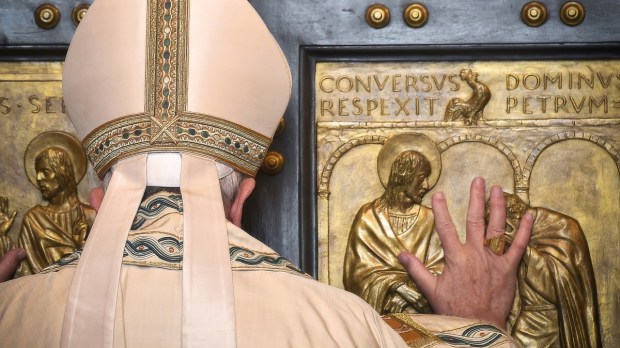Pope Francis has promulgated the Bull of Indiction for the Jubilee Year 2025. But what does it all mean? Here to help you, we offer a short glossary of some of the ecclesiastical terminology that might be confusing.
Jubilee
The Jubilee — or “Holy Year” — is a Catholic Church event now celebrated every 25 years. It is inspired by a Jewish tradition: in the Old Testament, the Law of Moses established a “year of grace” every 50 years, during which all slaves were freed, all debts were forgiven, and the land was left to rest.
Since the first ordinary Jubilee, instituted by Pope Boniface VIII in 1300, it has been customary for the faithful to flock to Rome during this special year, to experience God’s forgiveness. As they are now held every 25 years, this is the first ordinary jubilee since the Great Jubilee of the Year 2000.
There are also “extraordinary” Jubilees, such as the one Pope Francis declared in 2015 on the theme of mercy, or the one in 1933 for the 1,900th anniversary of Jesus’ death and resurrection. The Church will also celebrate an extraordinary Jubilee for the 2,000th anniversary of this event, in the year 2033.
Holy Door
Each of the four Roman major basilicas — St. Peter’s, St. John Lateran, St. Mary Major, and St. Paul Outside the Walls — houses a “Holy Door,” the symbol par excellence of the Jubilee Year. It represents Jesus, who declares in the Gospel, “I am the door. If anyone enters through me, he will be saved.”
By passing through these Holy Doors at the end of their pilgrimage, the faithful make a gesture of faith and spiritual encounter with Jesus, and receive an “indulgence.” Other Holy Doors may be opened around the world for local Jubilees. For the 2015-2016 Jubilee, the Pontiff chose to open the first Holy Door in Bangui, Central African Republic.

St. Peter’s Holy Door
Of all the Holy Doors, St. Peter’s is the most important. It is only opened by the Pope at the time of jubilees, and has marked their beginning since 1500. This door bears 16 bas-relief panels telling the story of humanity’s redemption, from the first sin to Jesus. It is usually sealed from inside the basilica by a brick wall, in which the box containing its keys is locked. Today, this wall is demolished a few days before the opening ceremony, and the pope no longer wields a hammer as in the old rite. Instead, he simply symbolically pushes the door open.
Indulgence
During the Jubilee, the faithful can receive indulgences. According to the Catholic faith, indulgences are remissions of the punishment people have incurred for their sins. An ancient practice in Christianity, indulgences are a sign of God’s forgiveness.
In concrete terms, there are two types of indulgence: “partial,” which consists of a partial remission of the purification of purgatory, and “plenary,” which exempts the faithful completely from the time due to be spent in purgatory. According to the Catholic faith, the faithful who die right after having received a plenary indulgence go directly to heaven. To benefit from an indulgence, however, the faithful must meet certain conditions. Usually, at the very least they are required to go to confession, attend Mass, and pray according to the pope’s intentions.
[See our primer on indulgences, part 1 and part 2.]
Bull of indiction
The Jubilee is proclaimed by a “papal bull of indiction,” which sets out the dates of the Jubilee year and the ways in which it will be implemented in Rome and around the world. The term “bull” (from the Latin bulla, round object) originally indicated the metal capsule used to protect the wax seal affixed to a papal document of particular importance, to attest its authenticity and therefore authority. Over the centuries, the term was used to indicate first the seal, then the document itself. Today, a bull is a letter from the head of the Catholic Church, written in solemn form — often in Latin. As is often the case with papal texts, the bull takes its name from the first words of the letter. It’s stamped with the seal of the reigning pontiff.
Major basilica
The title of “basilica” is given by the pope to certain churches, either because they house the relics of a saint, or because they are of particular importance to the faithful. Among the basilicas, four in Rome — St. Peter’s, St. John Lateran, St. Mary Major and St. Paul Outside the Walls — have a privileged status: that of “major” basilicas. They are also known as “papal” basilicas, because they are the property of the Holy See and are directly attached to the pope. The cathedral of the Diocese of Rome is the Basilica of St. John Lateran, not St. Peter’s Basilica.
Pilgrimage
Pilgrimage is one of the most important aspects of a Jubilee. The faithful are invited to set out on a “quest for meaning in life,” explains Pope Francis in the Bull of Indiction for the Ordinary Jubilee of the Year 2025. Over the centuries, many pilgrims have made the journey to Rome on foot — at least in part — during the Jubilee years.
In the Eternal City, various itineraries are planned for 2025, notably around seven churches — in this case, the four major basilicas, as well as St. Lawrence Outside the Walls, Holy Cross in Jerusalem and St. Sebastian Outside the Walls — and two “European” itineraries, following in the footsteps of the countries and saints of the continent.




